The Facts About the Grieving Families Act
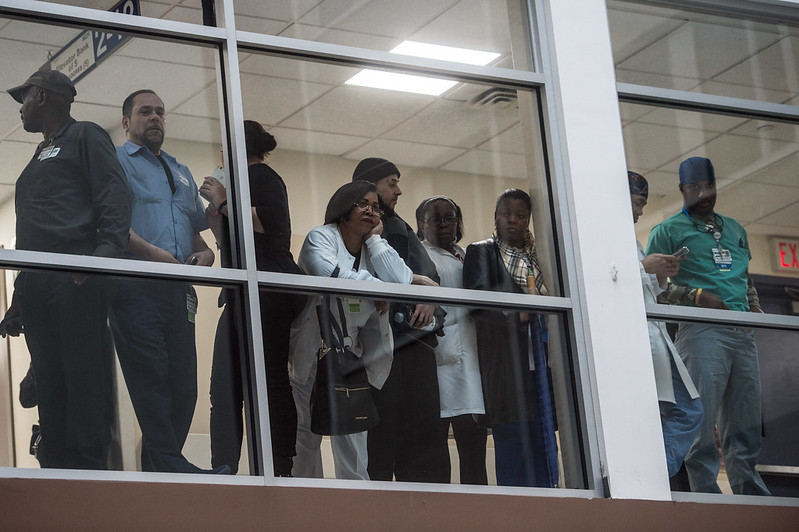
Facing life and death (photo: Michael Appleton/Mayor's Office)
Just the facts, ma’am.
That’s what fictional Dragnet detective Joe Friday used to ask for on TV decades ago. Today, the phrase is best known as a meme, but it’s still a good approach to decision-making in government. My colleagues and I should always look at the facts because that will point us towards the best course of action.
Rarely is this more apparent than in the discourse around the Grieving Families Act, which passed both houses of the Legislature by wide, bi-partisan margins and awaits action by Governor Kathy Hochul.
The Grieving Families Act reforms New York’s 175-year-old wrongful death law. If that sounds obscure, it’s not. This antiquated law currently says that if someone is killed, their lives are only worth what they earn for a living and the grief of their survivors is worth nothing. For example, because women earn just 83 cents on the dollar compared to men, their lives are worth 17% less if they are killed. The life of a retiree is basically worthless because they’ve already earned most of the money that they ever will. The same with the life of a child who isn’t working; incredibly, existing law accords little worth to the life of a child.
And, because the law only recognizes the 19th-century model of a family, many modern families are shut out of the courts entirely. The love and loss of grandchildren or domestic partners are legally worthless in New York.
If we were gathering the facts for Joe Friday, it would be indisputable that these are a pretty terrible set, utterly indefensible in our modern society.
As the Assembly sponsor of the bill, I introduced versions of the Grieving Families Act to correct these injustices every year since 1994, and this year with the crucial help of State Senator Brad Hoylman - sponsor of the Senate version of the bill - we finally beat the special interests and passed the bill through both houses of the Legislature.
But those same special interests aren’t giving up. Insurance company lobbyists are coming out of the woodwork trying to water down or even stop this legislation altogether. But they’re not offering the facts. Instead, they’re spreading ‘alternative facts’ like the Trump White House, and what our neighbors in Brooklyn, Manhattan, and beyond would simply call lies.
Insurance companies are claiming that this bill will cause malpractice insurance costs to skyrocket 40%. There’s no evidence for that. In fact, according to the American Medical Association, when Illinois reformed its wrongful death law in 2007 in a similar way, insurance rates for specialties such as surgery, internal medicine, and OB/GYN went down over the course of the next decade. That’s not even adjusted for inflation, the actual dollar amounts went down because the performance of financial markets plays the biggest role in rate-setting.
It's not the first time that the opponents of reform have tried to mislead us. When New York passed Laverne’s Law in 2018, the Medical Society claimed that it would cause a 15% rise in premiums for every doctor. Instead for the specialties such as general surgery, internal medicine, and OB/GYN, the state’s largest malpractice insurer either kept rates flat or even lowered them in every downstate county.
So using Joe Friday’s approach to government leads to a pretty clear set of facts: For too long, New York’s antiquated wrongful death law has undervalued the lives of many in our society, and the Grieving Families Act corrects this 175-year old injustice. Hopefully, the Governor will recognize the importance of correcting this injustice and will sign the bill as passed by the Legislature.
***
Assemblymember Helene Weinstein represents parts of Brooklyn. On Twitter @HeleneWeinstein.
***
Have an op-ed idea or submission for Gotham Gazette? Email This email address is being protected from spambots. You need JavaScript enabled to view it.
California and the Federalist Papers Offer a Path Forward on Housing, New York Should Take It
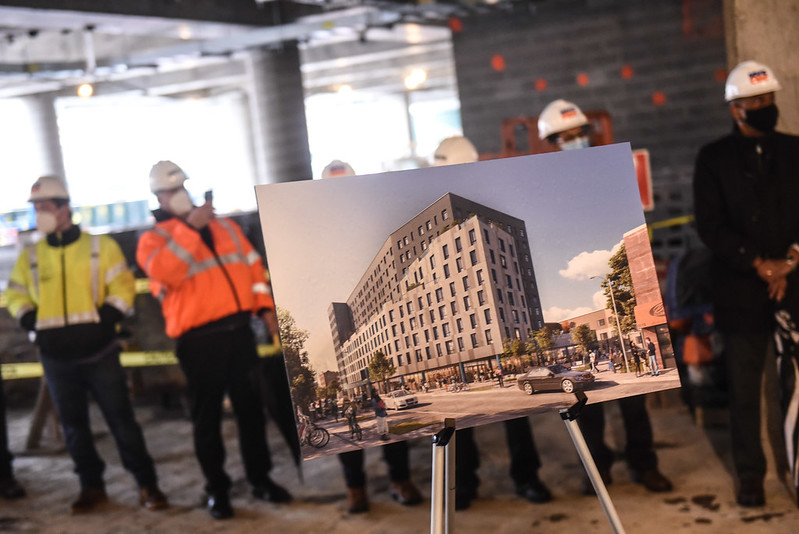
Housing in view (photo: Michael Appleton/Mayoral Photography Office)
The United States, and New York particularly, faces a housing crisis of its own making. Today, housing costs are the main driver of inflation, which is leading to painful interest rate hikes across the whole economy. And they’re the main driver of homelessness, an even more acute problem in high cost states like New York and California. In fact, for every $100 of increase in median rent, there’s a 9% increase in homelessness.
High housing costs lead to teachers, police officers, firefighters, and service workers being forced to live far from communities they work in simply to be able to afford a home. As distance between communities and their essential workers grows, so does distrust and lack of cohesion within them. And, housing costs are cited as a major driver of our inability to diversify and grow the economy. In fact, as numerous residents and businesses move to the Sun Belt, cheaper housing for workers is one of the most commonly cited reasons.
Prior localized efforts to build more housing in New York City and particularly its suburbs have failed, captured by NIMBYism (“not in my backyard” opposition) and parochial local politics. New York’s own Regional Plan Association estimates that half-a-million homes could be developed along New York City’s commuter rails alone by allowing housing density on properties already zoned residential, but few suburbs have allowed it.
New housing supply is severely below new housing demand because localities work to oppose new housing through means such as exclusionary zoning, parking requirements, and extended public comment periods that amount to filibusters to run out the clock. In New York, extreme NIMBYism has led to embarrassing episodes such as a recent viral video of a young man speaking in favor of an affordable housing project being shouted down at a Bronx community meeting.
Even in high-opportunity, transit-rich neighborhoods like Soho and Midtown West, you’d be hard-pressed to find many local elected officials who support upzoning their jurisdictions to develop more housing — something that would be very beneficial for the city and society as a whole but where there are hyper-local costs such as construction noise, property value changes, or blocked views.
Too many people presume that hyper-local direct democracy -- where neighborhoods get vetoes over what gets built -- is the American way. Yes, our fundamental unit of government is local, but NIMBYs do not have the sole claim to American history and traditions. For another way forward, look to Federalist 10, where James Madison makes the most forceful case for enlarging the sphere of decision-making so local communities could not kneecap widely beneficial policy.
In short, building housing has become a dysfunctional direct democracy issue – what Madison termed factional. Madison argues that "the most common and durable source of factions has been the various and unequal distribution of property." Today, the immediate costs of building housing are borne by immediate neighbors in the immediate future, creating political pressures on local officials, community boards, and towns to block housing with infinite delays in hearings and approvals. Coupling these pressures with the fact that voter turnout among homeowners is approximately 25% higher than renters, we have a perpetual public choice problem where our local governance perpetually under-approves housing.
These patterns were foreshadowed by Madison 230 years ago when he wrote “those who hold and those who are without property have ever formed distinct interests in society." Thus, Madison argues to combat the effect of faction, we must adopt a national Constitution that enlarges the sphere of interests.
Faced with localities continuously under-developing housing, this is exactly what California did in passing a landmark law at the state level that summarily approved housing as-of-right in underutilized commercially-zoned corridors.
California provided a way forward for New York and elsewhere as part of its effort to address its own shortage of 3.3 million homes by passing a statewide law that provided higher density zoning as of right for underutilized commercial properties (for comparison the New York City metro area alone has 516,000 fewer housing units than jobs and faces a shortage of 560,000 units by 2030 simply to account for current population growth). California’s success was made possible because it bypassed the NIMBYism of localities by building a statewide, broad coalition of business, labor, and housing advocates. The diffuse benefits of more housing were used to marshall public support at the state level even if they would likely fail at a local level where parochial interests rule.
I spoke to the architect of the law, AB 2011, California Assemblywoman Buffy Wicks, about the path to passing such a controversial but important bill. Wicks credited the passage of her bill to the visible failure of decades of NIMBYism with regard to aggregate housing.
“Every freeway ramp encampment, every city, is a visible reminder California has 27% of the country’s homeless population and it’s a very visible reminder of our failure on the housing issue,” she said.
“It takes 5, 6, 7 years to break ground on a project because of red tape and approvals,” Wicks added, and the housing construction industry is one that many people are exploited in and leave.
Her solution was a bill that ties together important pieces: it took as-of-right approvals statewide and out of local hands for specific projects that alleviate the housing shortage while using labor that pays a prevailing wage to bring workers back to the housing industry.
Another major component of the California victory was focusing on commercial corridors in order to sidestep residents who otherwise object to adding density to their current neighborhoods from single family to multifamily, the type of upzoning many reformers focus on most.
According to a quantitative analysis by Urban Footprint that Wicks credits for bringing California’s proposal to life, underutilized commercial corridors targeted by the bill could provide up to 2.4 million new homes, including up to 400,000 affordable to low- and moderate-income households across the state. This while increasing local tax revenues and providing substantial environmental benefits - it is estimated that these new units will produce 50% less greenhouse gas emissions than the average California household due to their density and proximity to already existing roadways, water mains, and sewage.
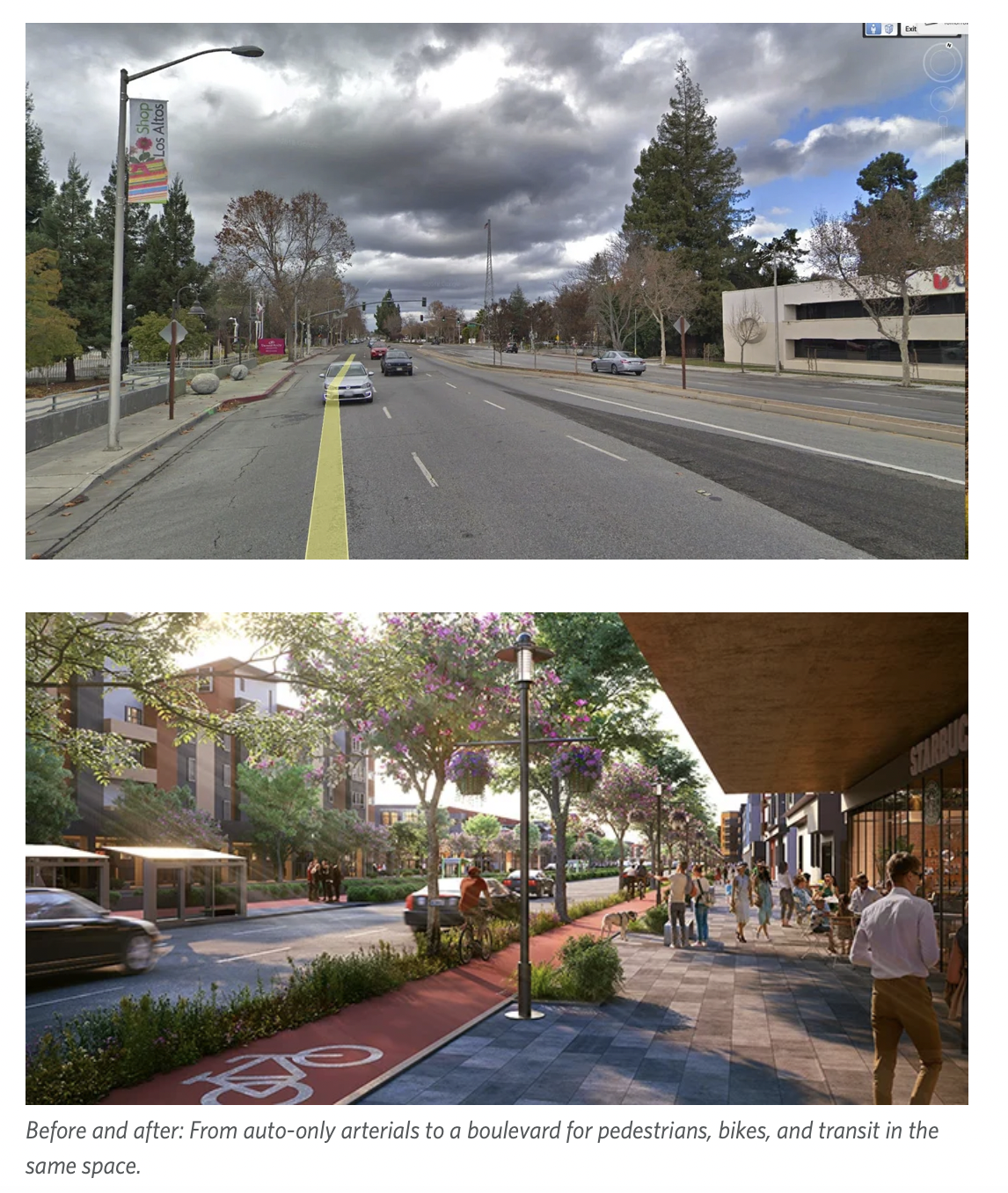
(source: Grand Boulevards: A Plan to Solve California’s Housing Crisis)
California’s new law creates two options for underutilized strip malls and commercial corridors along wide boulevards such as the Bay Area’s El Camino Real. Developers who choose to build 85% market rate and 15% affordable housing can build mixed-use housing with retail on the ground floor as-of-right with only ministerial approval, bypassing local councils and rezoning if they provide prevailing wages, raising the take home pay of people who work in construction and developing a much needed workforce.
Developers who choose to build 100% affordable housing do not have to pay prevailing wage. According to Assemblymember Wicks, starting with underutilized commercial corridors rather than upzoning existing residential zones helped bypass NIMBY opposition in part because people recognize that parking lots and strip malls are not efficient uses of space on major arteries.
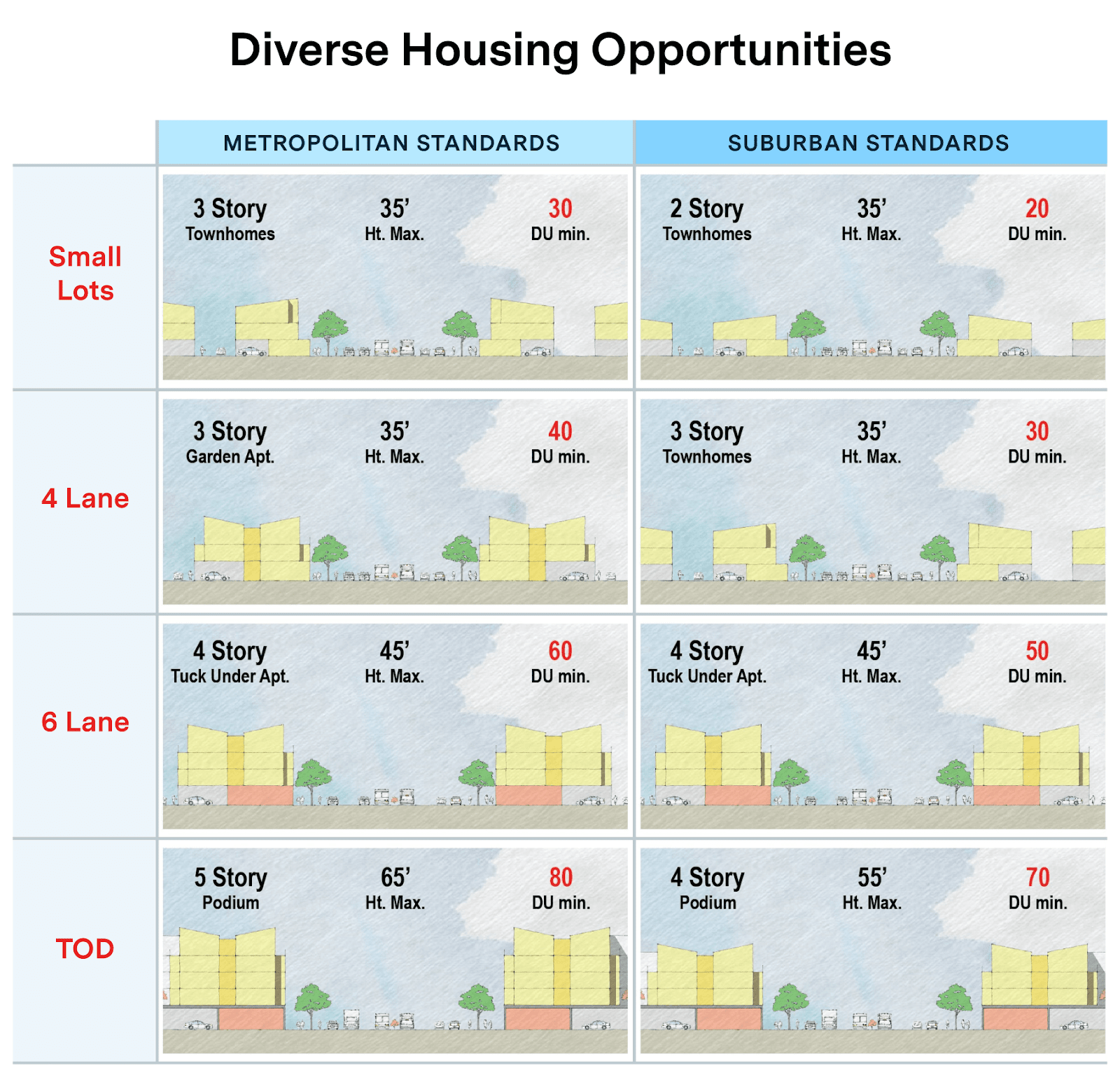
(Artist Conception of Commercial Corridor Based on Boulevard Size, Source: Urban Footprint)
California’s landmark housing victory would not have been possible without the broad coalition that realistically could be built at the state level without falling victim to Madison’s “factions” that can capture smaller units of government and politics. Wicks particularly credits support from service and education workers, who are often forced to live hours away from where they work, carpenters’ unions who do not belong to the large building trades but whose work goes primarily to housing, and even Republicans in the Assembly who are traditionally opposed to red tape and regulations. These are not the kind of groups who would necessarily show up to a community board meeting for a single housing development, where the benefits are often too narrow to attract attention and rally those focused on the greater good.
In New York, a similar statewide housing plan could apply to New York City and surrounding suburbs on Long Island and up the Metro North region. The state would designate an underutilized commercial corridor based on the width of a commercial boulevard or along a mass transit artery like the subway, LIRR, or Metro North. They would receive as-of-right mixed-used zoning with appropriate density based on corridor size, with only ministerial approvals in exchange for 100% affordable housing or 85/15% but using prevailing wage construction. Labor, business, and housing advocates would be able to succeed in getting more housing approved through this state level action than piecemeal at the local level.
In New York and across the country, building housing is a necessity. With the Federal Reserve hiking interest rates, there is no guarantee new housing supply will be added to meet demand. It’s a vicious cycle as housing costs now comprise the biggest portion of core consumer price index (CPI) increases year on year, which will continue to push the Fed to painful rate hikes and produce even fewer housing starts.
Now is the time to embrace the Madisonian model and take some decision-making out of the hands of localities that have proven they will not add housing, instead embracing essential growth for the good localities, states, and their residents. It’s a rare issue of bipartisan agreement with bills by Republicans such as Senator Todd Young of Indiana and Democrats like Senator Cory Booker of New Jersey pushing to clear hurdles and red tape to build more housing.
In New York, we ought to take a lesson from Madison and from California’s experience to embrace housing reform at the state level.
***
Suraj Patel is a professor and former candidate for Congress. On Twitter @surajpatelnyc.
***
Have an op-ed idea or submission for Gotham Gazette? Email This email address is being protected from spambots. You need JavaScript enabled to view it.
Growing to Love New York City’s Soils
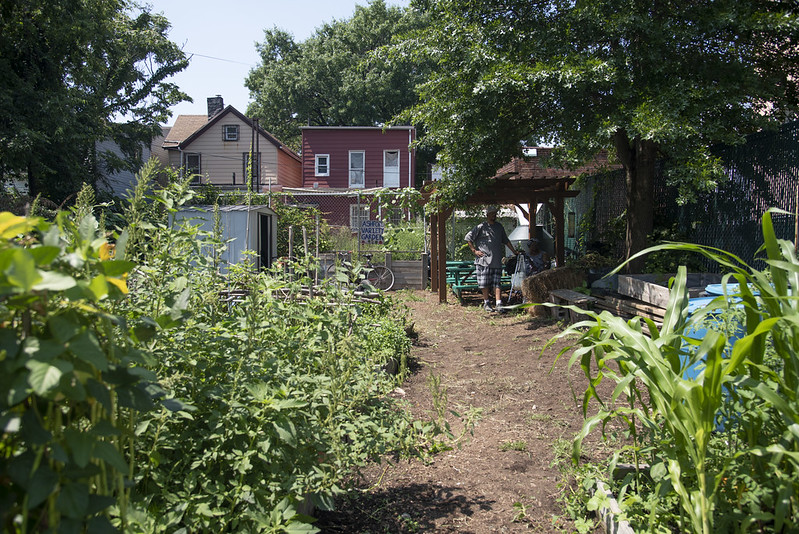
A community garden (photo: John McCarten/City Council)
As urbanites, it is easy to disregard the ground beneath our feet. As we sidestep tumbleweeds of trash or awkwardly circumvent waste from any of New York City’s 508,000 registered dogs, we tend to lose not only the forest and the trees, but also the dirt below. Even when we are in one of the city’s 1,700 parks, we probably are paying more attention to our friends or a good book than to what is growing underneath us. The dirty truth, however, is that we deeply rely on soils, and now more than ever. But, when was the last time we really took stock of the stuff?
World Soil Day, which happened earlier this month on December 5, focused on the theme: “Soils: Where food begins.” But for New York City residents, this topic can seem disconnected from our daily lives. Urban soils are an often-forgotten, critically important part of the city’s infrastructure. Community gardens and urban farms might be few and far between, and many New Yorkers may never have seen food growing in the city, but soils are all around us. All that is needed is a discerning eye to realize their presence and potential. Examining soils can help us understand the health of our city, performing a checkup, literally from the ground up.
Below, we outline four ways to promote soil health in the city, particularly for interactive soils in gardens, and get New Yorkers in touch with the soil, for their wellbeing and the quality of the shared environment. Whether it’s tree wells or parks or community gardens, urban soils represent a complex system we must appreciate.
1. Seeing Local Soils as an Intersectional Solution
Although 19 billion pounds of food are distributed throughout New York City each year – about 2,000 pounds per person on average – more than 1 million New Yorkers are still food insecure. In certain communities, like the South Bronx, this rate jumps from the citywide 12.5% to one-in-four. Rather than simply increasing food deliveries to funnel nutritious foods into these areas, exacerbating air pollution in communities that already suffer from suffocating amounts of tailpipe emissions, fresh food could be produced and supplied locally.
Programs, such as Farms at NYCHA and GreenThumb Community Gardens, do exactly this, expanding access to healthy foods while also providing valuable training and jobs. Community-centered urban agriculture might not be able to, on its own, serve the city all its food. Yet, when community members drive food production locally, it gives them pride and dignity in being able to provide for themselves while promoting food security in their neighborhoods.
More so, community gardens not only offer accessible food, they also enhance a community’s green space. They are more prevalent in communities with below-average access to parkland. Healthy soils are also climate-resilient soils – absorbing water during flash flooding or storm surges. Thus, they fulfill the purposes of food production and green space, while also giving the city much-needed protection against climate change.
2. Healthy Soils Promote Healthy People, More Than Just With Nutrition
In addition to food nutrients, community gardens convey bushels of benefits. They reduce stress, and soil microbes can even boost our serotonin levels – an important feature, with over 8% of New Yorkers suffering from moderate to severe depression.
Gardeners are also generally more active, which improves physical functioning. One segment of New York City’s population in particular – older adults – would especially benefit from getting down and dirty by stimulating both mind and body. But there are other important considerations as well: time spent in a garden can improve quality of life outcomes in dementia patients, which means that as New York City fosters an aging population, community gardens can play a big role in how we care for our older adults.
On the other end of the life spectrum, children benefit from getting into soils, too, and already 824 schools have garden programs and 140 schools are a part of the educational Farm to School program. Soils act like a living classroom, allowing hands-on learning in and out of school to teach about where food comes from, the microbiome, and other topics. This can all foster healthy relationships with food, and reduce obesity.
The city has educational programs centered around farming already in place, such as workshops at farmers markets and childcare centers. Other community educational spaces exist, including action centers leading events and outreach to seniors. But New York City has just some 600 community gardens to serve its more than 8.4 million residents. The goal of having gardens in all schools, in neighborhoods, and close to seniors is a multi-benefit one.
3. Put New York City’s Waste to Work
Soil is as much about where food begins, as where food ends. Compost-amended soil has better chemistry and fosters more biodiversity. In New York City’s community gardens, compost has even been shown to mitigate stormwater runoff, thereby attenuating flooding. Composting fights two battles at once: combatting the immense amount of organic matter that is sent to landfills and providing nutrients and benefits to urban soils for gardens, parks, tree wells, and other spaces.
Despite its continued importance, the city’s composting system has been in flux for the past three years, as COVID-19 disrupted momentum. A recent municipal pilot program in Queens has had success, collecting 5.7 million pounds of waste in just six weeks. This sets an example for curbside, no-opt-in-necessary programs, which could be rolled out in the future across boroughs. This can also put people in better touch with their food cycles.
And food waste isn’t the only kind of waste being considered in soil. The NYC PUREsoil program helps turn clean, deeply-excavated earth from construction into clean fill for community organizations, like gardens, rather than removing it as waste. Using what New York City already has by way of ground materials and pre-soil (aka food) and putting it to good use for the city’s soil fertility is a win on waste.
4. Equitably Incentivize Healthy Urban Soils and Ecosystems
In 2021, New York State followed the growing trend to prioritize soil. The State’s Soil Health and Climate Resiliency Act put into law a definition for soil health, suggestions for monitoring it, and encouraged collaboration between scientists and practitioners to better the quality of our agricultural soils.
The letter of this law does all of the above for rural, suburban, and urban soils. But New Yorkers know our city is unique, and this includes our soils – both their quality and how they are (under)prioritized. Part of the problem with urban soils is that economically, they are viewed as lacking what makes rural soils so important: food production. In a city, though, soils provide the services that we have described above and more. The value of urban soils should be incentivized, economically or otherwise.
To any pedestrian, walking down the sidewalk might give the impression that the concrete jungle doesn’t need or value its soil. But the lives of New Yorkers tell a different story.
Community gardens produce food and flowers on the land. We benefit from the protections that healthy soils offer when facing storms and excessive heat, both of which will only increase in their frequency and severity in the future. Coming out of this year’s World Soil Day, we are reminded we can all play a part in helping the Big Apple live up to its name – getting in touch with our food, getting down and dirty to care for city soils, and spreading the word about the brown gold beneath our feet.
***
Karl Palmquist is the Vice-Chair of the Sierra Club NYC Group and a systems biologist. He has worked on soil health issues at the state level, and developed science outreach programs for students to learn about soil. Mallory Rutigliano is a sustainability professional based in New York who holds an MPA in environmental science and policy and has worked in the fields of global policy, healthful behavior, and sustainable finance. She works on climate resiliency for the City of New York and is an active community volunteer. All opinions expressed in this column are the authors' alone.
***
Have an op-ed idea or submission for Gotham Gazette? Email This email address is being protected from spambots. You need JavaScript enabled to view it.
Bridging the Gap in Understanding the Link Between Domestic Violence and Brain Injury
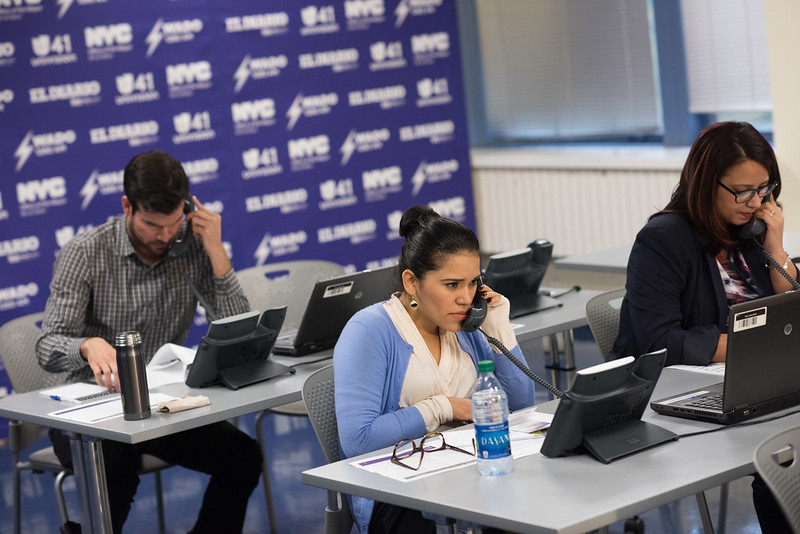
Answering the call (credit: Michael Appleton/Mayoral Photography Office)
If you ask most Americans to describe what comes to mind when you say the word “concussion,” they will likely describe a staggering football player being helped off the field. This is understandable, as football is fully enmeshed in our culture. When Miami Dolphins quarterback Tua Tagovailoa suffered a vicious head injury a few weeks ago, for example, the debate around his handling was a major media storyline. And, in recent years, concussion awareness in youth football is now standard.
That is good news: concussions and traumatic brain injuries (TBI) are serious medical conditions that can dramatically alter the trajectory of a person’s life. But we cannot solely focus on football players or even just men if we want to mitigate their impact and treat those afflicted. Instead, we need to broaden our horizons and recognize that TBIs are also dangerously linked to domestic violence.
The limited data we have paints a distressing picture. Annually, an estimated 10 million adults in the United States experience domestic violence and/or intimate partner violence, and 74% of domestic violence events involve injuries to the head or neck.
This suggests that the 1.5 million Americans each year who survive a traumatic brain injury, and the 230,000 hospitalized, is likely a serious undercount because domestic violence survivors are rarely assessed for concussions in interactions with law enforcement, medical care, mental health systems, or even victims’ services. In other words, there is a barely-noticed and highly-understudied public health epidemic primarily afflicting some of our most vulnerable neighbors.
There are several negative impacts stemming from the lack of awareness, data, and medical literature on this link.
First, and most importantly, survivors are simply not getting the care that they desperately need in the short term, extending their suffering. And the undiagnosed and untreated negative impacts of a concussion – including light sensitivity, foggy memory, and constant headaches – can impact future employability, credibility in the eyes of law enforcement, and even influence survivors’ self-worth.
This lack of resources can also perpetuate a vicious cycle of poverty. After all, domestic violence is a leading cause of homelessness for women and their children, and 41% of families entering the New York shelter system do so because of abuse. Many do not even know they may have a concussion or that they are suffering from long-term medical effects because they are focused on escaping the clutches of their abuser.
In other words, TBIs remain a major blind spot for America’s most vulnerable – and it is complicating the road to justice, recovery, and equality in New York and across the nation.
That is why our organizations, Volunteers of America-Greater New York (VOA-GNY) and Safe Living Space, partnered to create an innovative, first-of-its-kind TBI screening program at all seven VOA-GNY domestic violence shelters here in New York City.
When survivors and their families enter a VOA-GNY emergency domestic violence shelter, they will now be offered concussion screenings developed in partnership with the medical experts at Safe Living Space. Those in need of care will be connected to the Concussion Program at Northwell Health, where they will receive medical care.
In the short-term, this data will assure that all domestic violence survivors entering VOA-GNY residences have access to a full suite of TBI services and evaluations. It will also help to fill a glaring gap in medical literature around the link between DV and TBI as we build on these findings to create a formal study.
Of course, this work alone will not solve the many challenges facing survivors. Far from it. To do that, the many institutions working with survivors will need to account for the impact of concussions on the community and build a new infrastructure accordingly.
The good news is that we’ve done this with football and other sports – and now the time has finally come to extend that knowledge out into broader society and ensure that nobody is left behind to suffer in silence.
***
Myung Lee is the President and CEO of Volunteers of America-Greater New York, an anti-poverty organization working to end homelessness in the New York area by 2050. Dr. Edie Zusman is the CEO of Safe Living Space, a group of medical practitioners working to raise awareness of TBI. On Twitter @VOAgny & @SLS_MediaTeam.
***
Have an op-ed idea or submission for Gotham Gazette? Email This email address is being protected from spambots. You need JavaScript enabled to view it.
Governor Hochul Must Fulfill Her Promise of Compassion and Clemency; We Can Help
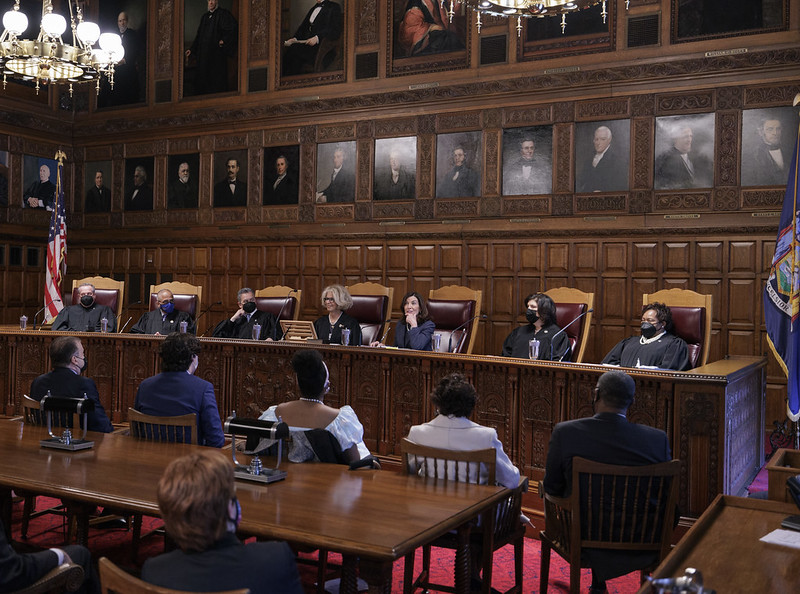
Gov. Hochul at the Court of Appeals (photo: Mike Groll/Governor's Office)
As we sat together in a Brooklyn backyard, we examined shared circumstances: all of us were convicted of serious crimes that caused immeasurable harm, received a life sentence, and served decades behind bars. Now, all of us have much to be thankful for – we each had our sentence commuted through clemency. Collectively, we reflect on the many people still in prison who merit the same consideration.
Each of us has been doing all we can to re-integrate into our families, communities, and society at-large. We tend to loved ones who are elderly and ailing. We work and engage with social justice organizations that provide support for incarcerated women and their children, and with case management services for formerly incarcerated persons. We help organize impacted communities in efforts to secure legislative reform around the pernicious effects of mass incarceration.
Gubernatorial grants of clemency -- the official recognition of redemption -- bring much needed hope to those in prison. Every time a sentence is commuted, it reverberates across correctional facilities. Those who may have resigned themselves to life in prison now leave their cells eager to focus inward on areas of growth through education and by participating in and developing programs to benefit themselves and others.
While granting clemency sends a clear message of hope, the converse is also true. When New York Governor Andrew Cuomo in 2015 and then again in 2017 rolled out a clemency project, anticipation spread like wildfire to people inside and their families outside that the governor would use his vast constitutional clemency power on an ongoing basis. And yet, we are among the fortunate few to reap the benefits of clemency.
To people serving massive prison sentences, false hope of the potential for release is often worse than no hope. The unwillingness to grant clemency to those who accept and acknowledge responsibility for the harm they caused, who have worked so hard to repair and transform, and who have been incarcerated for decades, magnifies the feelings of despair and futility that pervade prison life.
We know we are not special. We are first-hand witnesses to the many men and women who have used their time in prison to grow, improve, mentor others, and atone; to take stock of who they are and what brought them to prison. We know how much these men and women have to offer to everyone on the outside. Yet due to a criminal legal system that regularly inflicts massive, death-by-incarceration sentences, they face the reality of perishing in prison despite no longer in any way resembling the person they were decades earlier when they were first incarcerated.
New York Governor Kathy Hochul, in similar fashion to former Governor Cuomo, raised hopes when she promised to devote more resources to clemency and to issue grants on a regular basis rather than the typical once-a-year December announcement. We know too well the crushing disappointment when December 31 would come and go with at best a few people receiving clemency. The resulting anguish is palpable and is manifested by decreased involvement in various programs and activities, as people surrender to the reality of dying behind bars.
Governor Hochul’s clemency website provides that applicants should demonstrate “exceptional strides in self-development and improvement.” We know numerous people who meet and far surpass that criterion. We also know people serving life sentences for crimes committed when they were as young as 15 years old. We know people who are now in their seventies and eighties. We know people who are gravely ill. We know people who have selflessly devoted themselves to others in prison through hospice care, as mobility aides, and as sign language interpreters. And we know numerous people who have served 30, 40, or more years and present no threat to public safety. In fact, public safety would be improved if more people were returned to their families and communities.
We have banded together to amplify our voices. We call ourselves the Clemency Collective and hope that Governors will heed our message. Along with promising clemency on an ongoing basis, Governor Hochul created a clemency advisory panel. We hope the governor will also turn to us as a clemency resource. We know what it takes to prosper in the harsh confines of prison and the many challenges that people inside face every day. We have experience-based suggestions for how to improve the clemency process; to make it transparent and accessible so that it will inspire and motivate those inside to pursue life-affirming goals, as well as provide confidence to those in the community at-large that successful applicants for clemency are ready and able to safely re-enter and contribute to society. In the meantime, we raise our collective voice to implore Governor Hochul to fulfill her promise and begin granting clemency on a regular basis.
The Clemency Collective:
Colin Absalom
Roy Bolus
Ulysses Boyd
Richard Chalk
Judy Clark
Paul Clark
Rodrick Cole
Robert Ehrenberg
David Gilbert
Andre Jenkins
Gregory Mingo
Arnold Raimondo
Alfonzo Riley
Monica Szlekovics
Jon Adrian Velazquez
***
Have an op-ed idea or submission for Gotham Gazette? Email This email address is being protected from spambots. You need JavaScript enabled to view it.
Democrats Must Act on Immigration Reform While They Still Can

A naturalization ceremony (photo: Ed Reed/Mayoral Photography Office)
The midterm elections are now behind us and the lame-duck session is the perfect time to tackle a long-standing problem: immigration policy. The issue has a profound bearing on most Americans' communities and schools, as well as their economic interests and notions of justice.
Specifically, Democrats must finally codify the rights of Dreamers, those who are beneficiaries of the Deferred Action for Childhood Arrivals (DACA) program, and remedy continuing worker shortages in key industries like agriculture, health care, construction, and manufacturing, where non-citizen labor is ready, willing, and able.
Democrats – who control the House and Senate until January – have a tight window to make this right. And they have bipartisan support among Americans. They should seize the opportunity, effective immediately. 2025 may be too late.
DACA status Americans – the overwhelming majority of whom are young Latinos and Latinas – are foreign-born individuals who came to this country as minors. They are Americans and must enjoy the same rights as all citizens. They have grown up in our communities and places of worship, and in our schools, sports leagues, and civic organizations. They shouldn’t be expected to return to countries that are foreign to them and where their safety is at risk.
In recognition of the hazards posed by repatriating these young people to their countries of origin – most of them nations riddled by authoritarianism, violence, and crime, then-President Barack Obama issued an executive order, enabling DACA youth to remain in the U.S. temporarily to study and work, while legislative efforts could be advanced to provide them permanent resident status and a pathway to citizenship.
In recent years, however, the Trump White House resisted the efforts of DACA status young people to be permanently incorporated into our national life and economy, opposing their permanent residence and a fair process that would allow them to become citizens. Courts, where immigrant-unfriendly judicial appointments have increased, have also stymied efforts to protect DACA status for millions of young people.
Yet 74% of Americans, when polled by the Pew Center, overwhelmingly support making DACA rights permanent.
Further research and evidence finds that 'DACAmented' Americans are remarkably productive and law-abiding – as K-12 and college students, workers and entrepreneurs, and volunteers across the nation – wherever they reside, study or work. Some of these young men and women have also served admirably in the U.S. military.
Congress should resuscitate and pass HR-6. The Act would establish a clear pathway to permanent resident status for DACA beneficiaries, including the right to reside, study, and work in the U.S. It would also prohibit states from denying otherwise eligible DACA youth in-state tuition and benefits at public colleges and universities. California, New York, and five other states now offer tuition assistance for DACA recipients, but all students with DACA status deserve the same tuition benefits as their peers across the nation.
Such action is essential to develop a nationwide pipeline of strong workforce talent that is better aligned with our changing demographics and increasingly global economy.
For similar reasons, effective immediately, Congress should pass legislation to more fully mobilize available noncitizen workers; doing so can help to address persistent labor shortages in critical fields like home health care and child care, and aid various supply chain sectors beset by the recent covid crisis (from agriculture to retail, construction, and technology).
Expanding economic opportunity and agency for the nation’s young, fast-growing, and heavily immigrant Latino workforce is a worthy investment in our nation’s future. Latino students and workers, many of whom are Dreamers and non-citizens, are essential contributors to our evolving multicultural society and economy. We need practical and reasoned policy interventions to activate their still-not-fully-tapped contributions.
The measures we propose here will not provide the comprehensive reforms that are needed to address our nation’s many immigration challenges, but they will establish a practical start that is worthy of bipartisan support in the waning days of the current Congress. The time to act is now.
***
Félix V. Matos Rodríguez is chancellor of City University of New York. Henry A. J. Ramos is senior fellow at The New School Institute on Race, Power and Political Economy.
***
Have an op-ed idea or submission for Gotham Gazette? Email This email address is being protected from spambots. You need JavaScript enabled to view it.
Democrats Must Deliver for Asian-American Voters or Risk Losing More of Them
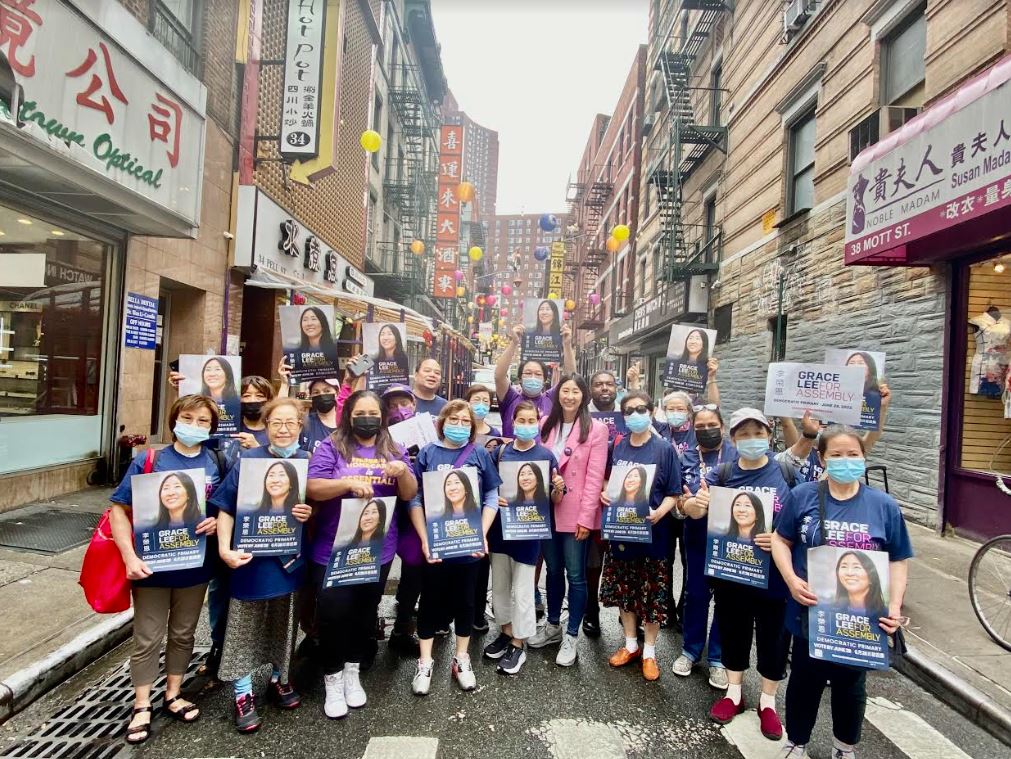
Co-author Grace Lee, center, with supporters (photo: @graceleefornyc)
As New York Democrats continue to assess our stunning midterm losses – including two state legislative seats in Southern Brooklyn with high concentrations of Asian American and Pacific Islander (AAPI) voters – our party must reckon with the fact that we have failed AAPI communities when it comes to both outreach and policy.
As the fastest growing demographic in the country, Asian-American voters will only increasingly count in future elections. We are 17% of the city’s population, a number that will continue to rise. We hold the power to deliver the margin of victory in competitive races and more, yet we deserve to be treated as more than just a margin; we deserve to have our voices heard and our communities cared for.
As Asian Americans, we are deeply invested in the future of our Democratic Party – Grace is the Assemblymember-elect for the district that includes Chinatown and the only electoral district that Lee Zeldin carried in Manhattan, and Trip is one of just a few top political consultants who identify as Asian American. We are calling on Democrats to waste no time in wrestling with the consistent exodus of Asian-American voters from the Democratic Party that we have seen over the last decade.
In 2012, exit polls showed 73% of Asian-American voters supported President Obama. Compare this to the 2022 midterms, in which 40% of surveyed Asian Americans voted for Republicans. While a presidential electorate differs from those who vote in the midterms, a 15-point drop-off is a five-alarm fire that Democrats should respond to with both urgency and intention.
Here in New York, Lee Zeldin won plurality Asian-American districts in Brooklyn and Queens. His crime-focused message undoubtedly resonated with Asian Americans, while Democrats failed to adequately tailor public safety messaging to Asian-American neighborhoods whose residents live in constant fear of hate crimes. Our party also failed to educate Asian-American voters about how Zeldin himself helped fuel the hate that led to a nearly 400% spike in anti-Asian American violence; as a member of Congress, he repeatedly tweeted reminders that the coronavirus came from China, and he even voted against Rep. Grace Meng’s resolution condemning anti-Asian American hate.
Republicans are shameless at pursuing the votes of the very populations they have marginalized, whereas Democrats take the support of Asian-American voters, and all communities of color, for granted. The consequences are visible: just looking at a map, big blocks of red now cover chunks of Brooklyn and Queens, which could easily metastasize into other historically Democratic areas of New York.
So where do we go from here? We need a top-to-bottom, brutally-honest assessment of what went wrong, accountability for mistakes that were made, and a clear roadmap of what needs to change.
For starters, we need to take a hard look at the way we build Democratic power in Asian-American communities, and that begins by building trust in our political and public leaders. We need to prove that Democrats will keep their campaign promises and respond to the needs of their Asian-American constituents.
We must invest in holistic solutions to public safety and improve the economic vitality of our communities. We need to engage Asian Americans early, not just in campaigning but in actual policy-making. If Democrats want to earn the support of Asian-American voters, then we cannot steamroll an entire population when it comes to declaring sweeping changes to education and quality of life that affect communities – as the former de Blasio mayoral administration had done.
Asian-American voices deserve to be heard on issues impacting their communities, and adequate translation services should be in place to ensure that language is not a barrier to civic participation.
We also need to examine the financial investment (or lack thereof) in how campaigns communicate directly with voters. We need to do the work of expanding our relationships to include a new generation of community activists. We need to hire campaign staff from the community and people who can communicate with voters in the language in which they are most comfortable. We also need to build a bench by recruiting and investing in Asian-American candidates and supporting Asian-American government staff and consultants as they move up in their careers.
Our messaging, too, needs to be thoughtfully constructed to reflect the issues that Asian Americans care about, like public safety and education. We cannot use blanket Democratic talking points for every demographic, plastered on translated mailers sent two weeks before an election. But if we are doing policy right and delivering on the issues that matter to Asian-American voters, then the messaging should follow naturally.
Above all, Democrats today need to recognize that Asian Americans do vote and we do count; across much of the country, Democrats exceeded expectations, and Asian-American voters contributed to these strong election performances. But if Democrats fail to invest in the hard work of organizing Asian-American communities now, we will continue to snatch defeat from the jaws of victory.
***
Assemblymember-elect Grace Lee will be the first Korean-American woman to serve in the New York State Legislature, representing District 65 in Manhattan. She is a community organizer and mother of three young children. Trip Yang is the founder and president of Trip Yang Strategies, a political strategy and paid media consulting firm. He was named by City & State as one of New York’s Top Political Consultants in 2022. On Twitter @graceleefornyc & @TrippyYang.
***
Have an op-ed idea or submission for Gotham Gazette? Email This email address is being protected from spambots. You need JavaScript enabled to view it.
No One Can See The Future: New York Needs Second-Look Sentencing Before More Lives Are Wasted
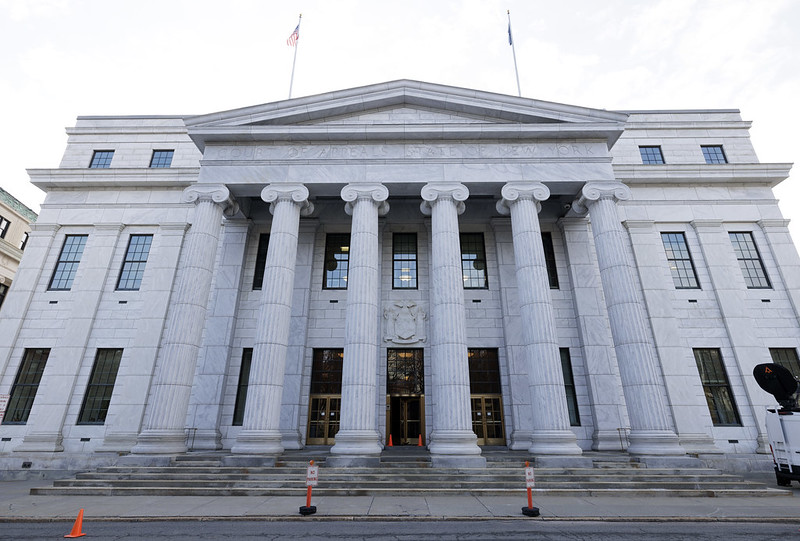
The Court of Appeals (photo: Mike Groll/Governor's Office)
The past few years have put into stark relief our inability to predict the future. Virologists, epidemiologists, and related medical professionals repeatedly reevaluate their views regarding COVID-19 and its variants. Economists daily revise their opinions about inflation, interest rate hikes, and the likelihood of a recession. Political pundits and pollsters are scurrying to explain why their election prognostications were off the mark. No one can gainsay the limited ability of meteorologists to accurately forecast the weather beyond a few days.
And yet in our criminal courts, judges act as if they have the power to see into the future. It is commonplace for judges to hand down maximum sentences as they emphatically proclaim that the person in front of them is irredeemable and will forever be a threat to society.
In apparent recognition of and response to this judicial hubris, the American Bar Association’s House of Delegates approved a resolution that encourages legislation to provide for judicial “second look” review of all criminal sentences. Such legislation would mandate a reevaluation of sentences where individuals have been incarcerated for ten years, regardless of original sentence or crime of conviction. Notably, the resolution received the unanimous support of the ABA’s Criminal Justice Section Council, a group comprised of judges, prosecutors, and academics, as well as defense attorneys.
The resolution is a recognition that people, including those convicted of serious and often violent crimes, can and do change. Public attitudes about crime also change as evidenced, for example, by the movement to legalize marijuana. Our understanding of behavior evolves as neuroscience now reveals that brain development and the corresponding ability to control impulses and consider consequences continues into our twenties. It is also appropriate, if not imperative, to re-examine sentences simply because it is illogical to think that a sentence once imposed remains just, necessary, and appropriate in perpetuity.
It is also becoming increasingly clear that not all victims or family members of a victim demand lengthy prison terms for the person who caused harm. The restorative justice movement is shining light on innovative approaches to harm and trauma and the needs and desires of those who have been harmed by violence. “Second look” reviews can amplify the burgeoning restorative justice movement by promoting conversation about alternatives to relentless punishment.
Further, second looks are not just about beneficence or mercy. There is much talent that is wasted behind bars. People languish on the inside when they could contribute on the outside as mentors to young people who might end up making the same mistakes that they did at similar ages. They could help repair families and communities that have been devastated by the draconian sentencing of the past several decades. More directly, second look sentencing can return fathers and mothers to support their sons and daughters, and restore sons and daughters to act as caregivers to aging parents. Returning citizens can and do revitalize communities and promote public safety.
To be clear, the American Bar Association resolution does not call for automatic resentencing. It is not a guarantee that anyone will be released. Rather, the potential for resentencing will provide hope for those serving long sentences that they are not necessarily consigned to die in prison. Second looks provide a powerful incentive for incarcerated people to take whatever steps they can to grow and improve, and to confront and address the confluence of factors that led them to where they are, the harm they caused, and what they can do to try and atone.
The ABA resolution is by no means an outlier.
Senator Cory Booker and Representative Karen Bass introduced the Second Look Act in 2019 to permit people who have served ten years in federal prison to petition a court for resentencing. In the meantime, federal court judges are using the First Step Act and compassionate release to find compelling reasons to resentence people given long sentences. Some states have taken steps to rectify past decades of massive sentences that were often motivated by racist tropes like “super predator,” “wolfpack,” and “wilding,” by passing legislation authorizing the right to seek resentencing for those convicted when they were young.
New York is among the states that presently do not provide any mechanism for sentencing review beyond the immediate direct appeal. A bill, the Second Look Act, addresses that omission by allowing judges to review and reconsider excessive sentences. It is long overdue as there are more than 7,500 people serving life and very long-term sentences in New York prisons.
Consider just one example. When Bryon was a young man, he and friends made the rash decision to rob some local drug dealers in upstate New York. In the ensuing chaos, one person was shot in the leg. At sentencing, the judge expressed his view that Bryon was irredeemable, stating, “You should be locked up for a very long period of time to protect other God-fearing, law-abiding citizens . . . you should be kept under lock and key for the absolute maximum period of imprisonment of the time they can keep you there.” Bryon was ultimately sentenced to 50 years.
The passage of time has proven the judge wrong – 21 years later, Bryon has grown into a mature, thoughtful, and accomplished adult. He has not received a single disciplinary ticket for violent conduct. He serves as a GED tutor and is taking college classes. He facilitates alternatives to violence and related programs. He has written apology letters to his victims to take full responsibility for his actions and to express his heartfelt remorse. Recently, he and his wife organized a bookbag giveaway as an effort to try and repair the harm he caused to his community. Without the Second Look Act, Bryon will remain behind bars for decades to come.
Many are familiar with the sentiment expressed by Sister Helen Prejean and civil rights lawyer Bryan Stevenson that no one should be judged by the worst thing they ever did. It seems appropriate to amend the statement – no one should be judged in perpetuity for the worst thing they ever did. It is exactly the “in perpetuity” that forecloses the recognition of redemption and mandates the need for second looks.
***
Steven Zeidman is a professor of law at CUNY School of Law. On Twitter @SteveZeidman.
***
Have an op-ed idea or submission for Gotham Gazette? Email This email address is being protected from spambots. You need JavaScript enabled to view it.
New York City Needs Housing for Everyone, Not More Shelter Beds
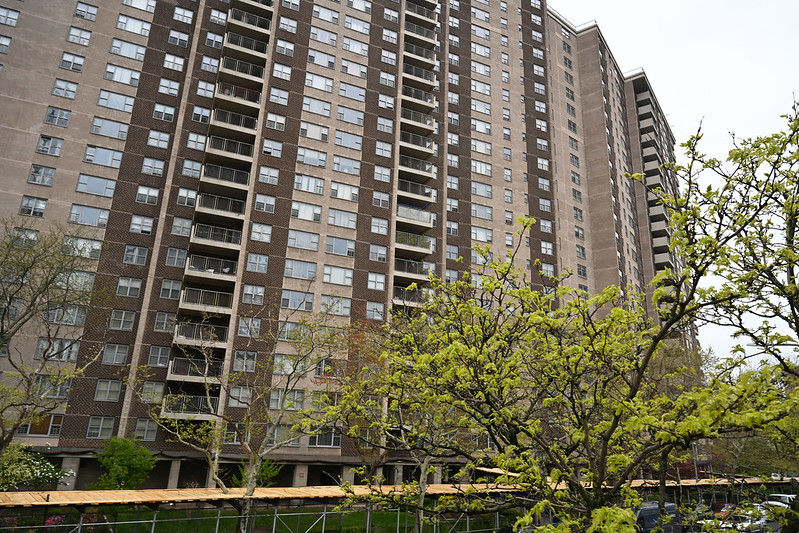
Housing (photo: Kevin P. Coughlin/Governor's Office)
Faced with an influx of migrants, the main shelter system bursting at the seams, and skyrocketing rents, New York City Mayor Eric Adams declared a state of emergency. The response to this perfect storm has since involved the opening of emergency shelters, building tent intake centers, and even negotiating with cruise line companies to possibly house those in need.
What’s clear is that both our insufficient temporary and permanent housing systems fail those most in need. If we are to turn back the tide on this growing crisis, the path to preventing and solving homelessness runs through creating a new paradigm for housing people.
My tenure leading RiseBoro Community Partnership has taught me that opening more shelters is not the right solution for New York City’s homelessness crisis. Our city’s right to shelter mandate has laid the groundwork for the expensive and inefficient shelter system, but despite billions of dollars in annual expenditures, we are no closer to solving the problem. Meanwhile many tens of thousands of New Yorkers continue to suffer in shelters and on the streets every night. If we are to solve this crisis permanently, we must shift our mindset from a right to shelter to a right to housing.
In a city and nation as wealthy as ours, there’s no excuse to not provide permanent affordable housing to everyone who needs it. Affordable means rent is no more than 30% of a household’s income, the federal standard. Everyone needs an affordable place to live, and when we dedicate such a large share of our resources to shelters over permanent housing, we miss the opportunity to end homelessness.
To be sure, creating a real right to housing in practice will not be easy. It will require a multi-pronged approach that catalyzes new housing production and expands rental assistance for those who need it. The resulting effort may have a large price tag but the city is already spending over $3 billion annually on homelessness. We can’t keep trying to bail water out of this sinking boat with a leaky bucket. We have to plug the hole, and a shift to a right to housing would do that.
For this to be a reality, we need to start by making development in the city cheaper and easier; New York is a notoriously difficult and expensive place to build housing. While there were measures for positive developments proposed in Albany that ultimately failed to pass this year, such as the removal of caps on the size of residential housing development, more needs to be done if New York is to be a place where residents can find an affordable place to live and become thriving members of the community.
To achieve this vision, we should start by reforming New York’s byzantine zoning and land use processes so that all neighborhoods share the responsibility of building additional housing. Next, we must address our outdated property tax system, which puts huge tax rates on large rental properties. Finally, we must invest more in the production of affordable housing, both in terms of capital dollars and in the city agencies that are charged with facilitating development.
Affordable housing is needed throughout the city. Most of New York City’s relatively meager housing growth has been concentrated in a small number of neighborhoods. Since 2010, 10 of the city’s 59 community districts accounted for 47% of new housing permits, and one-third took place in five neighborhoods: the far west side of Manhattan, Downtown Brooklyn, Williamsburg/Greenpoint, Long Island City, and Astoria. We need more infrastructure in disinvested neighborhoods, like the West Farms section of the Bronx, one of the poorest districts in the city. Proposals like Senator Brad Holyman’s — which would shut down racist local zoning laws — would help make this dream a reality.
We also need more creative solutions, like converting hotels and single-room occupancy buildings into affordable housing units, to become the norm. Last year, RiseBoro completed such a project on the Upper West Side for 135 homeless seniors.
Finally, we need broader efforts through legislation to address the housing and homelessness crisis. Senator Brian Kavanagh’s proposal to include $250 million in funding for the Housing Access Voucher Program (HAVP) in the state budget would have been a big step forward, and though it failed this year it should be taken up in 2023. The proposal would support many of the 92,000 New Yorkers across the state currently experiencing homelessness by providing funds to house over 40,000 people in just the first year of the program.
Mayor Adams’ first city budget included $22 billion for housing over the next decade, but that still falls well short of candidate Adams’ $4 billion-per-year pledge for housing.
Creating enough housing is no doubt an expensive proposition, but inaction will cost us far more.
A supportive housing bed and wrap-around services cost $42,000 per year, well short of the $550,000 per year that a bed at Rikers is costing. The difference underscores a real cost-burden of not reducing homelessness, as the unsheltered are 10 times more likely to have contacts with police, nine times more likely to experience jail spells, and twice and three times more likely to require ER services or ambulance rides, respectively.
New York can’t make this shift on its own. The federal Inflation Reduction Act (IRA) that passed, scaled back from the more ambitious Build Back Better plan (BBB), provided $1 billion to the Department of Housing and Urban Development (HUD) for grants supporting climate efforts in affordable housing projects. This is a long way off the $175 billion promised in BBB to build and support affordable housing. This loss of needed federal funding continues to hamstring local efforts to reverse the homelessness crisis and provide enough quality, affordable housing for everyone.
Working at RiseBoro, I see how affordable housing changes people’s lives every day. And my vision of a vibrant and diverse community doesn’t end with housing. Residents must have access to a full range of services that address their needs. Young people must have safety and opportunity to fulfill their potential. It must be a community with healthy food, healthy families, and healthy housing. Without affordable and stable housing, everything else is less effective. Temporary housing only dooms other services to be temporary. We must look beyond the right to shelter and collectively strive toward a right to housing.
***
Scott Short is CEO of RiseBoro Community Partnership. On Twitter @RiseboroNYC.
***
Have an op-ed idea or submission for Gotham Gazette? Email This email address is being protected from spambots. You need JavaScript enabled to view it.
Criminalized Survivors Deserve Sentencing Reform
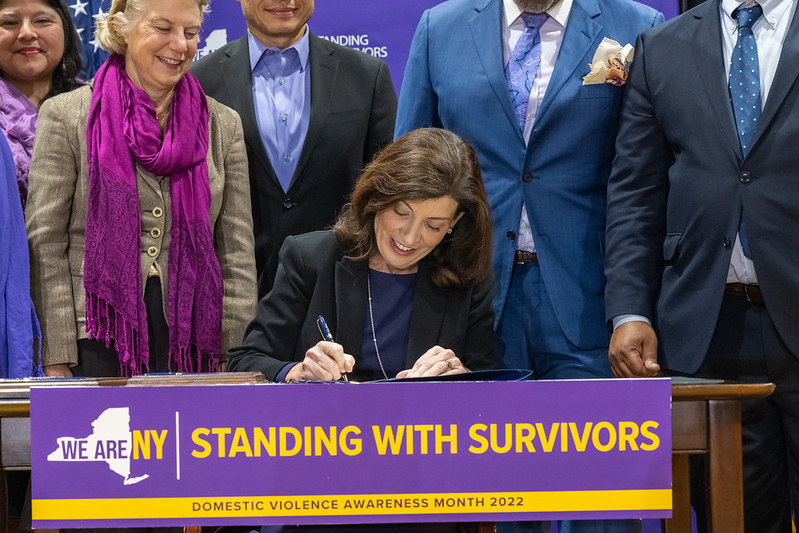
Gov. Hochul signs legislation (photo: Darren McGee/Governor's Office)
Although it might sound counterintuitive to some, sentencing reform is necessary to effectively address intimate partner violence and support victims.
To start with, sentencing reform benefits criminalized survivors, victims of violence convicted of crimes related to their own victimization. Sometimes the victims of these crimes are their abusive partners; sometimes the crimes are committed at the behest of, or under duress from, their abusive partners.
Mandatory-minimum sentences are partly to blame for the substantial number of survivors who choose to plead guilty rather than face trial. Confronting the possibility of long terms in prison and “trial penalties” assessed for failing to plead guilty if they are convicted, women take pleas even in cases where they might have credible defenses. They take pleas so that they can get home to their children sooner, to protect their children from having to testify, and because they think they will not be believed.
The Domestic Violence Survivors’ Justice Act (DVSJA), passed in 2019, provides some relief from harsh mandatory minimums and creates a mechanism for reconsidering draconian sentences in some cases. But the DVSJA does not reach all of New York’s criminalized survivors.
For example, in November 2020, a 48-year-old woman who filed a DVSJA application was denied relief despite an extensive history of documented abuse from infancy through early adulthood and despite the fact that her abusive partner (who was the person harmed in the offense) supported her release. The court found she wasn’t a victim of domestic violence “at the time of the offense” (a criterion that must be met to qualify for relief) because it didn’t recognize the psychological abuse by her partner or the cumulative effects of childhood trauma. Since her incarceration she has come to better understand how trauma has affected her life and helps women on the inside grapple with the same issues she’s had to overcome. She is now entering her seventh year of a 16-year sentence.
Cases like this demonstrate why criminalized survivors are calling for sentencing reform, particularly the passage of the Eliminate Mandatory Minimums Act and Second Look Act, both under consideration by the New York State Legislature.
The Eliminate Mandatory Minimums Act would allow judges to consider mitigating circumstances - like abuse and trauma - rather than requiring them to impose a lengthy prison sentence regardless of circumstances. The Second Look Act would allow judges to review and reconsider excessive sentences. Right now, there is no mechanism outside of the DVSJA in New York State to reassess those sentences.
As a law professor who directs a Gender Violence Clinic providing direct representation to incarcerated survivors of intimate partner violence, sexual assault, and trafficking, it is abundantly clear to me that we have spent decades pursuing the wrong solutions to gender-based violence.
There is no evidence that harsh criminal sanctions like lengthy periods of incarceration or mandatory minimum sentences, which require judges to impose specific sentences for particular crimes without enabling them to use discretion in individual cases, decrease or deter intimate partner violence. But there is reason to believe that such sanctions make future violence more likely.
Intimate partner violence is highly correlated with economic hardship. Male under- and un-employment is strongly associated with perpetration of intimate partner violence (and with domestic violence homicides), as is experiencing other economic stress. People with criminal records, especially those who have spent years or decades in prison, have more difficulty finding and keeping work, are often employed in jobs with high turnover and little potential for growth, and earn less than people who have not been criminalized. They frequently live in economically distressed areas, and living in such neighborhoods is also correlated with higher rates of intimate partner violence.
Criminalization also causes trauma. It’s ironic that people who are being punished for violence are sent to places where they are likely to be victims of or witnesses to violence. There are few resources to help incarcerated people recognize and process the trauma that they have experienced, both before and during their incarceration. As a result, when they are released, formerly-incarcerated people take that unprocessed trauma with them back into their communities and their intimate relationships. That trauma can lead to post-traumatic stress disorder, which is highly correlated with the perpetration of intimate partner violence.
Prisons aren’t the way to end intimate partner violence. Yet we continue to pour resources into the criminal legal system, hoping, despite the best available evidence, that somehow incarceration will lead to positive outcomes for people who use violence and for their partners. And we do that despite the knowledge that not only is incarceration not working, but that it is harming those it was meant to protect.
We need to invest in the things that might end violence rather than continuing to throw money at prisons, even “gender responsive, trauma informed” prisons. We need to redirect the billions of dollars that currently go to the criminal legal system into economic stimulus, public health prevention, and communities. And we need to get people out of prison and back into communities, where they can heal, work, parent, and thrive. Yes, even for intimate partner violence, communities not cages is the right policy choice.
***
Leigh Goodmark is a law professor at the University of Maryland where she co-directs the Clinical Law Program, teaches Family Law, Gender and the Law, and Gender Violence and the Law, and directs the Gender Violence Clinic, a clinic providing direct representation in matters involving intimate partner abuse, sexual assault, trafficking, and other forms of gender violence. On Twitter @LeighGoodmark.
***
Have an op-ed idea or submission for Gotham Gazette? Email This email address is being protected from spambots. You need JavaScript enabled to view it.
Don't Believe the Hype; Bail Reform is Good Policy and Good Politics
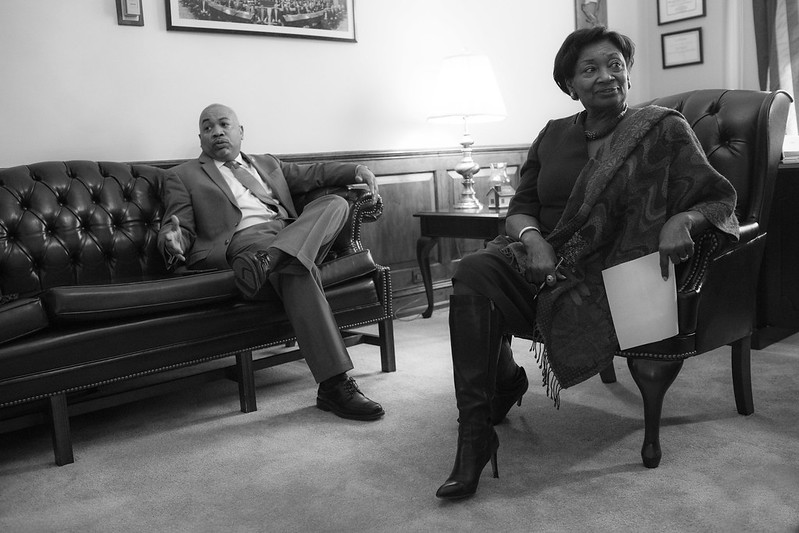
Speaker Heastie & Majority Leader Stewart-Cousins (photo: State Senate)
In 2019, Democrats in New York were feeling pretty good. New York City had its first two-term Democratic mayor since the 1980s. Democrats controlled the Governor’s mansion in Albany and every other statewide office. We controlled the State Assembly and the State Senate – both with commanding majorities.
Washington, of course, was a mess. One party was in the thrall of a former game show host, and they were too afraid of upsetting him to get anything done. Say what you will about New York’s one-party rule. But here, at least, there was a real opportunity to make progress for people in need.
So that year, Democrats in Albany took a big swing. They finally reformed the cash bail laws that had, for decades, made a mockery of our criminal justice system and didn't make us any safer. Prior to these reforms, many New Yorkers accused of low-level crimes ostensibly had two options. They could sit in jail while they waited for their day in court, unable to work or prepare their defense. Or they could buy their way out.
But those options were only available to people with money. The ones who could afford to pay up of course did so. But many couldn’t – and so a disastrous, two-tiered criminal justice system took hold: one for the rich, and another for the poor. No New Yorker was any safer for rich people buying their way out, or poor people languishing in jail.
The reforms took away cash bail for low-level offenses, while maintaining it for alleged very serious or violent ones. They reunited countless New Yorkers with their families. They kept people who hadn’t been convicted of anything out of Rikers Island and other hellish jails. They finally made an unfair, racist system a little fairer.
And then the storm came.
I’m a longtime political consultant in New York, and I’ve never seen anything like it. Republicans and their media allies responded with manufactured rage from even before the law was changed and never stopped. They ignored the practicality of the reforms, which kept those accused of the most violent crimes in jail and leveled the playing field for everyone else. Every crime committed anywhere, by anyone, was suddenly a direct result of bail reform. They spent millions of dollars running bail-related attack ads before the 2020 elections — an attempt to terrify New Yorkers and benefit from a national crime spike.
Republicans told anyone who’d listen that voters would punish Democrats for their overreach and take away their 40-seat majority in the State Senate.
When the dust settled that November, Democrats had won 42 seats in the 63-seat Senate. The majority became a supermajority.
Maybe New York Republicans quietly blamed their failed, unpopular president. But they might have had a clue what voters were really experiencing if they had looked at the data. Bail reform was working. Study after study found no correlation between bail reform and any increase in crime. The New York Post examined NYPD data on gun violence and found that less than 1% of the 11,000 people released from jail in early 2020, when bail reform first went into effect, were involved in a shooting. More recently, as Nassau County leaders falsely blamed any crime on bail reform, their own study found that few are re-arrested.
Instead of following the data, Republicans tripled down.
Lee Zeldin’s run for governor was the darkest campaign in recent memory. He talked about bail reform almost every day. And he had help; Republicans poured millions in campaign donations to groups supporting him.
With no game show host to drag them down, Republicans were even more confident this year. They were sure a red wave would crash on New York – one that would cut a gash in the Assembly and Senate majorities, and maybe even sweep Zeldin into the Governor’s mansion.
Once again, it didn’t happen. Democrats won 41 seats in the State Senate this year. With one race heading to a recount, it could be 42. The Assembly supermajority is as commanding as ever. And Lee Zeldin lost by hundreds of thousands of votes.
Here’s what that means: after three years of predictions that bail reform would sink those who passed it, the Democratic Party has gained representation in state government.
Crime, of course, is still an animating issue for voters across the state. And Republicans likely won tight races for the House of Representatives by exploiting it. Many of those races were winnable; it’s hard to escape the feeling that we should have done even better. But the House of Representatives didn’t pass bail reform. Democrats in the State Legislature did – and New Yorkers, in two straight elections, ignored a tsunami of persuasion to reward them for it.
Politics is a tough business. But one thing remains true: voters will support you for doing the right thing, no matter how much money is spent to convince them not to. New Yorkers have asked for solutions on public safety, not scare tactics. They’re ready to address what’s really driving crime. Ignoring the data gets us nowhere.
With next year’s legislative session around the corner, Democrats will have another chance to enact bold changes. There’s plenty left to do; our criminal legal system still targets people of color and the poor, and advocates are bursting with ingenious, practical solutions. Democrats in Albany should give those policies a fair hearing, and act decisively. The politics will work in their favor. Be brave.
***
Jason Ortiz is a Democratic political consultant and the co-founder of Moonshot Strategies. On Twitter @hotroddy95 & @MoonshotNYC.
***
Have an op-ed idea or submission for Gotham Gazette? Email This email address is being protected from spambots. You need JavaScript enabled to view it.




